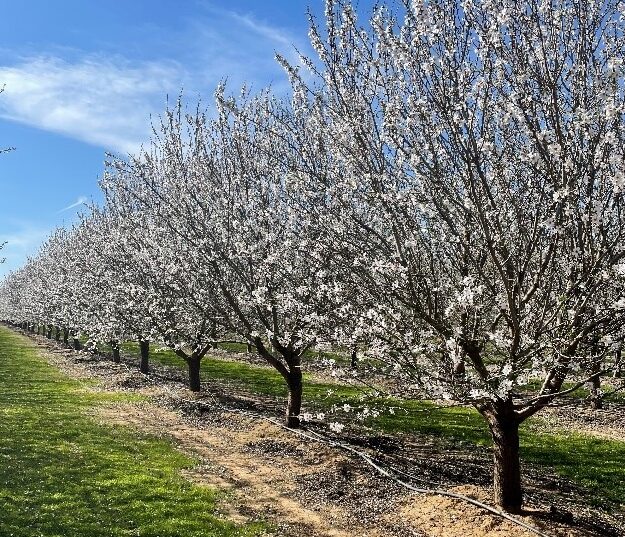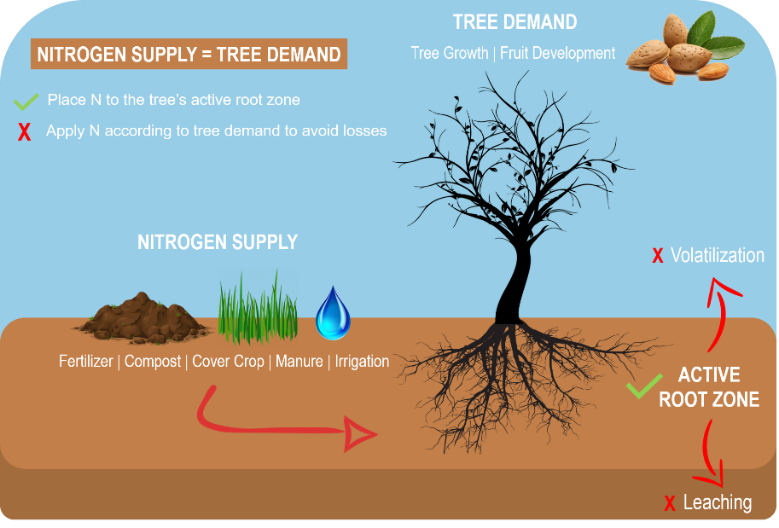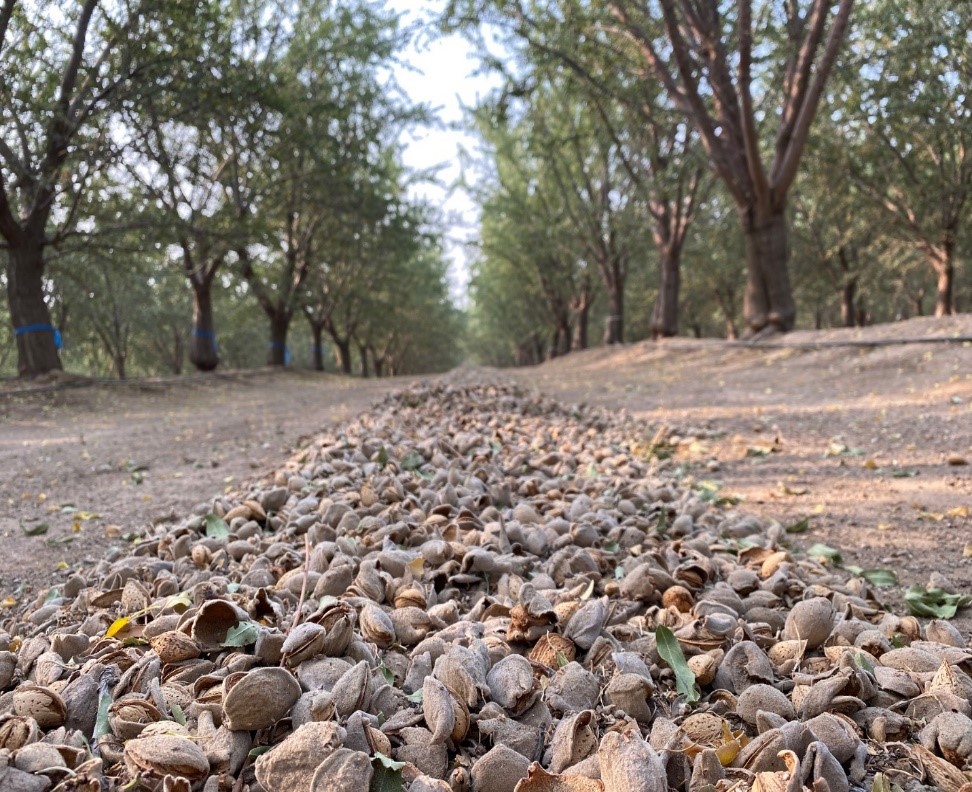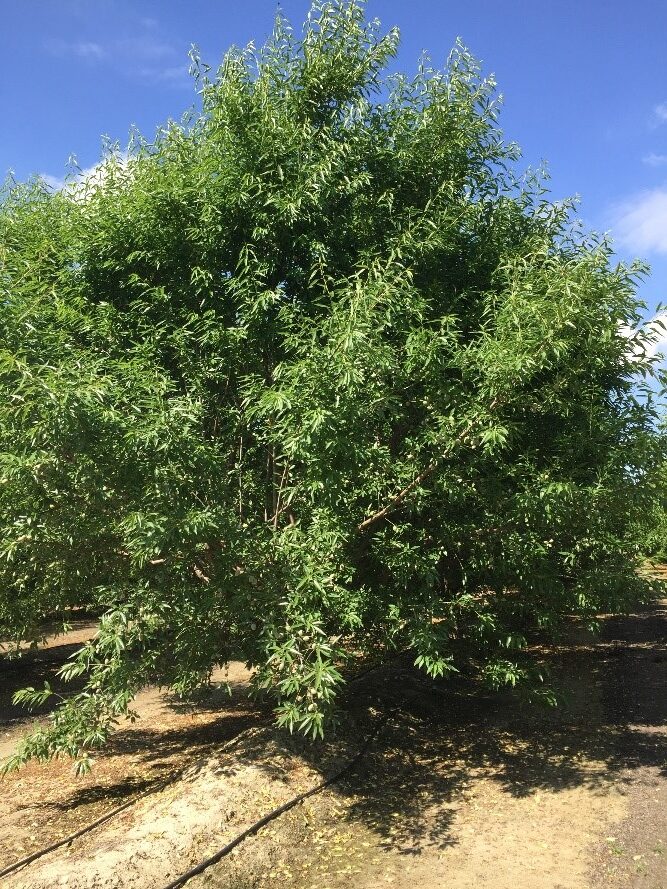
With growing season upon us, an understanding of the seasonal uptake of nitrogen is essential to time fertilizer applications. Nitrogen fertilizers are the most important chemical input in modern agriculture. Among all essential nutrients for higher plants, N is required in the largest quantity. It is estimated that over 100 million tons of N fertilizers are applied globally. However, this number could be much lower if our farming systems used N more efficiently. Typically, less than half of the applied N is utilized by the crops while the rest is lost to air and water by run-off, leaching, denitrification and volatilization.
Due to excessive use of N in California, the Irrigated Lands Regulatory Program (ILRP) implemented new regulations to prevent agricultural runoff from impairing surface waters, requiring every grower to implement a N management plan. As a result, there is a growing pressure for all of ag to ‘tighten’ the efficiency of N use, and it requires an improved understanding of N demand to grow almond.
Nitrogen in Plants
Nitrogen is essential for a wide range of processes in plant production. It is the major element found in chlorophyll, which is needed for photosynthesis, the most important of all the plant processes, converting the sun’s energy into carbohydrates. It is also needed for the formation of amino acids (the building blocks of proteins, major component of the almond kernel) as well as DNA and RNA, which are the genetic materials that allow cells (and eventually plants) to regulate growth, development and reproduction.
Matching Supply with Tree Demand
Managing N in almond orchards is a balancing act of supply versus tree demand. When making fertilization decisions, growers need to consider the different supplies of N as well as the demand for N due to tree growth and kernel production requirements. An understanding of all different N (re)sources (fertilizer, compost, cover crop, manure, irrigation water) and how N can be “lost” (volatilization, leaching) in the orchard will help growers better make management decisions.

Understanding Tree Demand
As previously stated, N is essential for a wide range of processes in tree production such as growth of all annual (flowers, leaves and kernel) and perennial organs (branches, trunk and roots). However, the primary factor impacting N demand in trees four years and older is kernel yield. Based on a study developed by UC Davis professor Dr. Patrick Brown and team, it is estimated that with every 1,000 pounds of almond kernels produced, 68 pounds N are exported from the field and an additional amount of N is required to satisfy the trees’ annual growth demand. Thus, potential yield estimation early in the season can have a significant impact on N management decisions. Growers can normally make these estimations based on their orchard productivity over the past years combined with the expected productivity of similar orchards in their growing region, environmental conditions of the prior year, winter chill and spring flowering conditions.
Approaches to Improve N Management
In order to achieve maximum productivity and to reduce N losses to the environment, close attention to the 4R’s— Right Amount, Right Time, Right Place and Right (re)Sources—is needed in all orchard fertility programs.
Remember, you need to TRAP the N in the soil:
TIME nitrogen application according to tree uptake patterns,
Identify and understand available nitrogen RESOURCES (fertilizers, composts, manure, cover crops, irrigation water),
Apply the AMOUNT needed according to tree demand, and;
PLACE nitrogen to the tree’s active root zone.
Following the 4R’s principle can be viewed as a balancing act with the goal of applying adequate N to supply tree demand for growth and fruit production.

Timeline of N Uptake in Almonds
Proper rates and timing of N fertilizer are important for managing the delicate balance between vegetative and reproductive growth while avoiding losses to the environment. Therefore, using small and frequent fertilizer applications during the season will have a significant impact on tree production and reduction of N losses by adjusting application according to the trees’ needs.
It is important to note that N reserves that are built up in the previous season are used to support early growth the following spring. It means that perennial organs are an important additional sink of N during winter. The remobilization of internal N reserves is therefore crucial for optimal shoot growth, flowering and fruit set since bud break occurs when conditions (end of winter) are not optimal for root N uptake. Thus, maintaining your trees’ health throughout the season is essential.
As described in the provided table, N uptake from the soil closely follows the development of fruits and shoots, increasing in March after stored tree nitrogen is depleted (70% leaf out) and slowing dramatically after hull split.
Excessive Use of N
While it is always important to ensure sufficient N supply for optimum growth and yield, it is equally important that we do not assume that more is better. Nitrogen is the nutrient most often abused in terms of a ‘more-on’ approach. Excess N can cause several problems.
When nitrogen is overapplied, it negatively affects the uptake of other nutrients. Overapplication of nitrogen is associated with higher incidence and severity of hull rot, which may affect nut quality and food safety. Excess N can also cause excessive vegetative growth in the current season, thus compromising the production of next year’s flower buds and subsequent production of next year’s crop.
Additionally, plants cannot absorb all the excess nitrogen in the soil and extra N levels will leach out of the soil. As a result, groundwater and drinking water become contaminated from the nitrate levels.
Improving Nitrogen Use Efficiency
Nitrogen management plays an important role in determining your bottom line, so ensure you manage this nutrient well in order to keep tree performance, production and nut quality up as well as costs down. Some approaches that can be adopted to minimize risks and optimize N use include applying N to meet tree demand and according to tree uptake patterns. For this, an efficient irrigation system is essential. Fertilizers must be present in the root system where they are most likely to be used by the tree.
In summary, adopting the 4R’s principle will help growers to improve N management, sometimes achieving over 80% efficiency under optimal conditions. However, every individual orchard must have a specific N management plan (there is no “one-size-fits-all” approach), and grower judgment remains critical. A complete N management guide for Almonds (ABC N-BMP 2020 guidance) has been recently developed by the Almond Board of California (see related story in this issue of West Coast Nut magazine) in cooperation with UC researchers and can be accessed at almonds.com/almond-industry/orchard-management/soil-health-and-nutrients/nutrient-management.











